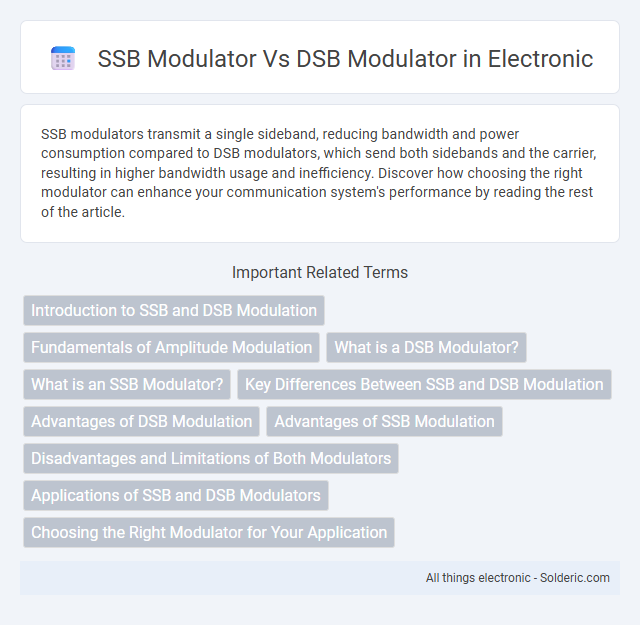SSB modulators transmit a single sideband, reducing bandwidth and power consumption compared to DSB modulators, which send both sidebands and the carrier, resulting in higher bandwidth usage and inefficiency. Discover how choosing the right modulator can enhance your communication system's performance by reading the rest of the article.
Comparison Table
| Feature | SSB Modulator | DSB Modulator |
|---|---|---|
| Full Form | Single Sideband Modulator | Double Sideband Modulator |
| Bandwidth | Half the bandwidth of DSB | Uses full bandwidth, twice that of SSB |
| Power Efficiency | High (only one sideband transmitted) | Lower (both sidebands transmitted) |
| Complexity | Higher (requires filters or phasing) | Lower (simpler implementation) |
| Signal Quality | Better spectral efficiency, less interference | More susceptible to interference, less spectral efficiency |
| Use Case | Long-distance voice communications, amateur radio | AM radio broadcasting, simple analog transmissions |
| Carrier Presence | Suppressed or reduced carrier | Carrier transmitted at full power |
Introduction to SSB and DSB Modulation
SSB (Single Sideband) modulation transmits only one sideband of the original signal, either upper or lower, reducing bandwidth usage by half compared to DSB (Double Sideband) modulation, which sends both sidebands. Your communication system benefits from SSB modulation through improved spectral efficiency and reduced power consumption, making it ideal for long-distance or bandwidth-limited transmissions. While DSB modulation is simpler and used in amplitude modulation, SSB offers superior performance in avoiding redundant information and interference.
Fundamentals of Amplitude Modulation
SSB (Single Sideband) modulators transmit only one sideband of the amplitude-modulated signal, significantly reducing bandwidth and power consumption compared to DSB (Double Sideband) modulators, which transmit both upper and lower sidebands along with the carrier. In amplitude modulation fundamentals, DSB modulation generates two mirror-image sidebands around the carrier frequency, each carrying the same information, while SSB eliminates one sideband and the carrier, enhancing spectral efficiency. SSB modulators require precise frequency and phase synchronization to recover the original message signal at the receiver, offering advantages in long-distance communications and bandwidth-limited channels.
What is a DSB Modulator?
A DSB modulator generates a Double Sideband (DSB) signal by amplitude modulating a carrier wave with the input message signal, producing two symmetrical sidebands around the carrier frequency. Unlike Single Sideband (SSB) modulation, which transmits only one sideband to conserve bandwidth and power, DSB modulation transmits both sidebands, effectively doubling bandwidth usage. DSB modulators are simpler but less efficient, commonly used in traditional AM radio broadcasting where spectral efficiency is less critical.
What is an SSB Modulator?
An SSB (Single Sideband) modulator efficiently transmits only one sideband of the signal, reducing bandwidth usage compared to a DSB (Double Sideband) modulator, which transmits both sidebands. This selective transmission enhances spectrum efficiency and power utilization, making SSB modulators ideal for long-distance communication and voice transmission. Your communication system benefits from improved signal clarity and reduced interference by using an SSB modulator.
Key Differences Between SSB and DSB Modulation
SSB (Single Sideband) modulation transmits only one sideband of the carrier signal, significantly reducing bandwidth and power consumption compared to DSB (Double Sideband) modulation, which transmits both sidebands. DSB modulators are simpler but less efficient, consuming twice the bandwidth of SSB and suffering from redundancy and interference issues. Your choice of modulator affects spectral efficiency, transmitter power requirements, and overall communication quality in radio transmission systems.
Advantages of DSB Modulation
Double Sideband (DSB) modulation offers simpler implementation and better spectral efficiency compared to Single Sideband (SSB) modulation, making it advantageous in systems where complexity and cost are critical factors. DSB modulation ensures full transmission of both sidebands, which improves signal robustness and ease of demodulation in basic receiver designs. The symmetry of DSB signals also facilitates straightforward envelope detection, beneficial in analog broadcast and AM radio applications.
Advantages of SSB Modulation
SSB modulators offer significant advantages over DSB modulators by transmitting only one sideband, which reduces bandwidth usage by half and improves spectral efficiency. This efficiency results in lower power consumption and decreased interference, making SSB ideal for long-distance communication. Your communication system benefits from enhanced signal clarity and increased channel capacity when using SSB modulation.
Disadvantages and Limitations of Both Modulators
SSB modulators suffer from increased complexity and higher implementation costs due to the need for precise carrier suppression and sideband filtering, which can lead to signal distortion if not accurately maintained. DSB modulators, while simpler, face significant bandwidth inefficiency as they transmit redundant information in both sidebands, resulting in wasted power and spectral resources. Your choice between these modulators must consider these trade-offs, with SSB providing bandwidth efficiency at the expense of complexity, and DSB offering simplicity but with greater power consumption and bandwidth usage.
Applications of SSB and DSB Modulators
SSB modulators are widely used in long-distance communication systems such as amateur radio, marine, and aviation communication due to their bandwidth efficiency and reduced power consumption. DSB modulators find applications in short-distance or less bandwidth-sensitive systems like AM broadcast radio and simpler communication setups where signal complexity and power efficiency are less critical. The choice between SSB and DSB modulation depends on specific requirements like channel bandwidth, power availability, and signal clarity.
Choosing the Right Modulator for Your Application
SSB modulators offer higher spectral efficiency and reduced bandwidth usage compared to DSB modulators, making them ideal for long-distance communications and applications where bandwidth is limited. DSB modulators provide simpler implementation and are often preferred in scenarios requiring robust signal transmission and ease of design. Your choice between SSB and DSB modulators should consider factors like power efficiency, bandwidth constraints, and the complexity of your communication system.
SSB modulator vs DSB modulator Infographic

 solderic.com
solderic.com